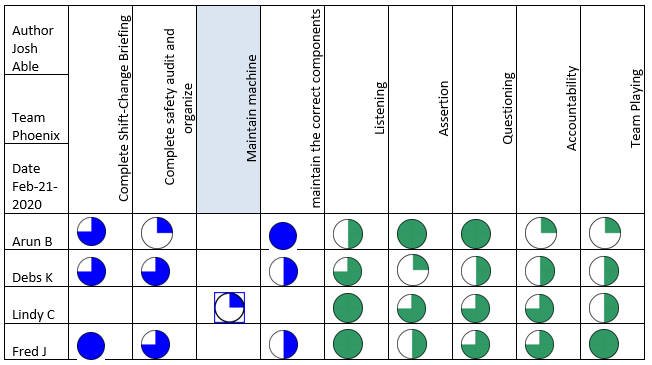WHIN Monthly Bulletin
GE and Wabash National operate all Personal Development Reviews with 50% of the total being ‘Behavioral Norms’; not just technical skills and outcomes. At Glencore-Xstrata, I facilitated[1] the introduction of a similar program in one of the five Divisions of this largest mining company in the world, with 25% ‘Behavioral Norms’. I also introduced and consulted with other organizations including Government at Westminster, UK.
To improve self-worth and engagement, it is good to involve senior staff at the very least and not just roll out a program from the top. The Behavioral Norm program should be embedded with the Personal Development Review (PDR) and come out with a few headline objectives (try not to exceed five) for work-culture’s ‘Behavioral Norms’. For example only:
For each of the above, set out not more than 3 or 4 top behaviors that can be observed by others.
For each of the Behavioral Norms it may be helpful to calibrate with a score (see below) and to do that, illustrate the behaviors that can be observed at say, level 1, 4, 7 (staff who are between levels would then be scored appropriately). Here is an example for THREE Traits a company makes for ‘Empowering’:
Actively asks for new ideas and suggestions, acknowledges these and gives credit where these lead to improvement
Level #1: Occasionally asking for ideas and suggestions from staff, possibly with little or limited acknowledgement
Level #2: Routinely asks for ideas and suggestions but may not record these with the date/context/name
Level #3: Routinely asks for ideas and suggestions; keeps a dated record with contexts and names of people contributing specific ideas and tracks back to these to acknowledge in 1-2-1 and in a team environment when there has been team and or corporate adoption of an idea/suggestion
Encourages initiative in others where they may be able to take the lead in planning and implementing change
Level #1: Tends to own the ideas of others and manage these
Level #2: Encourages others to develop their good ideas and listens/reads/feeds-back on these
Level #3: As Level #2 and: assists in opening doors for their development of ideas and a part in implementation where the idea/suggestion is approved.
Delegates responsibility and decision-making to enable results to be achieved quickly.
Level #1: Rarely delegates. Tends to over-manage or under-manage and does not question and listen to find out the motivators (carrots and sticks) that work for particular individuals
Level #2: Sometimes delegates but may often over-manage without questioning/understanding the support/resource needs of the staff-member
Level #3: Often delegates and uses questioning up-front to check that outcomes and first few steps are rational and will work, even if not matching what the supervisor/manager would do. From questioning, knows what level of support/resourcing is needed by the delegate to achieve the agree outcomes.
A Likert Scale of 1-6 or 1-7 is best, as most people can instantly fix on a number without secondary thinking to internally-calibrate the distinctions. The range also allows for progress over a longer period of time.
It is best if the individual rates themselves, not rated beforehand by the supervisor/manager. This avoids the potential for negative surprise, disappointment and anger that may happen if completed by the boss.
The review should ALWAYS take place as time-tabled and NEVER put off, as that invariably is understood as a covert message that the person is not important/valued enough by the supervisor/manager.
The supervisor/manager should ask questions rather than make statements/judgements. These questions need to encourage the individual to think and clarify the reason for their scores/ranking:
“You put 3 our of 7 there. Tell me what strengths and lesser-strengths lead you to this score?”
“I remember that you had a situation with person X last week and whether what happened, and the outcome, lead you to reconsider your rating?”
“The evidence I am seeing, for example, X, Y & Z., suggest to me that you your score should be 4 and not 3 there; would you agree with that assessment?”
“The evidence I am seeing, specifically A, B & C., suggest that your score of 5 is a little too high. I believe you have work to do on your behavior of {interrupting others} and listening, responding more calmly with others and so suggest a rating of 4; do you agree with this and if not, why not?”
“We seem not to agree on that rating after our discussion so far. I can leave your rating as it is and in that case, will be taking care to see evidence of the behavioral changes that I have told you need to happen. Alternatively, if you like, I shall have Learning & Development go through the evidence we have reported here and ask them for an independent view of this. Which option appeals to you more”.
The norms should be posted up or digitally displayed. They should also form part of every planned meeting resources and all staff should be encouraged and expected to refer to the norms and be empowered to call out non-conformance, politely, when seen in any other employee, at any level of seniority. The valued behavioral norms need to be expressed in web-presence, hiring, including advertising and also, within work-contracts with both staff and contractors.
It is good to consider Reward and Recognitions structures to acknowledge those who do well or make considerable progress in manifesting the norms.
Within teams, it is also good to consider a visual system that sets out both the job-skills ratings of all the team, but also their agreed level in the behavioral norms too. Here is one to consider where the green symbols are for the behavioral norms and the blue ones for a team working on a manufacturing line; though the model is applied similarly for any team situation whether an office one or not.
 |
Understands the (plant) behavioral norms (stage 1) |
|
 |
Demonstrates a good working use of the behavioral norms (stage 2) |
|
 |
Demonstrates improved working use of the behavioral norms (stage 3) |
|
 |
Can demonstrate all behavioral norms seamlessly and is ready to remind others, politely, and at any level of seniority, if the behavioral standard is not being met by that other person. |
|
 |
Understands the steps required to complete the prescribed task
|
|
 |
Performs the task safely and to quality specification but not to takt-time[2]
|
|
 |
Performs the task safely, to quality specification and to takt-time.
|
|
 |
Can supervise and mentor the task to the Task Developer Standard
|
|
 |
Is certified to do repairs (boxed symbol) on all equipment used during the task
|
|

Lindy C is in maintenance but in an emergency, could, with supervision, use a machine due to her skills in in maintaining it.
[1] Circa. 2014-2015.
[2] Takt-time is the rate at which a finished component/product task needs to be completed in order to meet the production criteria (and/or the customer demand).